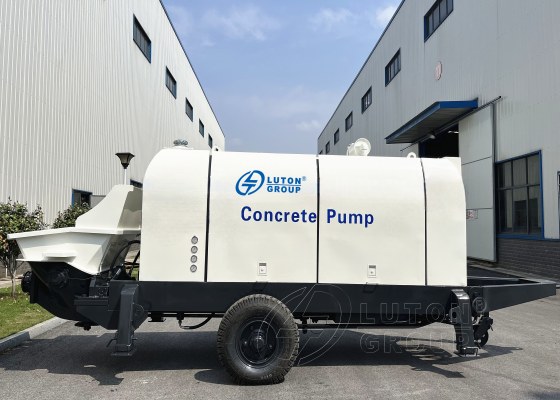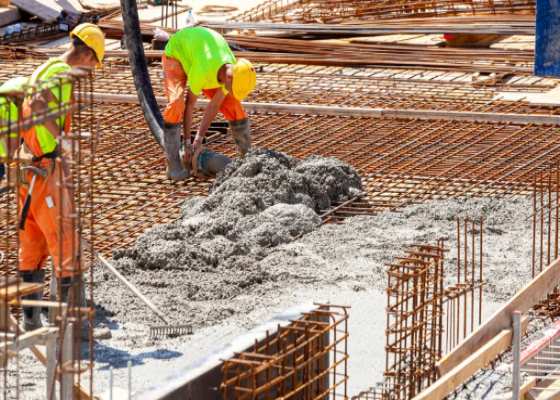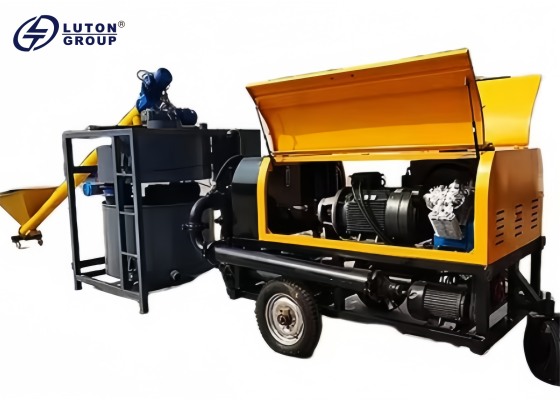Can an ordinary concrete pump deliver lightweight concrete? At first, it might sound reasonable, both materials are made of cement, sand, and water. However, when you move from theory to jobsite reality, the story changes dramatically.

Lightweight cocnrete behaves very differently, and using the wrong pump can lead to serious problems such as pipeline blockage, foam collapse, or equipment wear.
This article provides a professional, field-tested analysis – exploring the technical feasibility, equipment adaptability, actual risks, and replacement solutions for lightweight concrete pumping.
Difference Between Ordinary And Lightweight Concrete
Although both types of materials share the same cementitious base, their composition, density, and pumping behavior are completely different.
| Property | Ordinary Concrete | Lightweight Concrete |
| Density | 2300-2500 kg/m³ | 300-1800 kg/m³ |
| Aggregate Type | Crush stone, gravel | Foam bubbles, perlite, expanded clay |
| Pump Pressure Requirement | 6-10MPa | 2-5MPa |
| Viscosity | High | Low to medium |
| Flow Stability | Stable under high pressure | Sensitive to pressure and vibration |
| Typical Use | Structural colums, slabs, bridges | Roof insulation, void fillllig, block production |
To answer the question “can an ordinary concrete pump deliver lightweight concrete pump?”, in short, ordinary concrete is heavy and coarse, while lightweight concrete is airy and delicate. Therefore, they require different pumping mechanisms and parameters for safe and efficient delivery.
Why Ordinary Concrete Pumps Are Not Ideal
Even though a regular concrete pump can technically move lightweight concrete for short distance, it is not the best choice for consistent or large-scale production.
High Pressure Destroys Foam Structure
Lightweight concrete, especially foam concrete, contains millions of tiny air bubbles.
The high pumping pressure of a standard concrete pump (usually 8-10MPa) can crush these bubbles, leading to:
- Density loss (material becomes heavier)
- Poor insulation performance
- Reduced compressive strength
Pipeline Blockage and Backflow
Standard pipelines (usually 125mm diameter) are designed for coarse aggregates.
When used for low-density materials, they often cause uneven flow, leading to segregation or backflow inside the system.


Increased Equipment Wear
Lightweight concrete contains fine powders and foaming agents, which can cause cavitation or air gaps inside the pump cylinders.
Over time, this leads to premature wear of pistons and seals – increasing maintenance costs.
Inefficient Output
Most ordinary concrete pumps are designed for 30-90m³/h output, which is far beyond the need for lightweight concrete applications (typically 5-20m³/h). This mismatch results in unstable flow and inefficient operation.
The Right Solution – Lightweight Concrete Pump
A lightweight concrete pump (also known as a foam concrete pump) is specially engineered for low-density, fine-material concrete.
It operates with lower pressure, smaller pipes, and precise flow control, ensuring smooth and uniform pumping.

These pumps are also available in electric or diesel versions, suitable for both indoor works and remote construction sites.
Key Technical Parameters
| Specification | Lightweight Concrete Pump | Ordinary Concrete Pump |
| Output Capacity | 5-20 m³/h | 30-90 m³/h |
| Max. Pumping Height | 40-80m | 100-200m |
| Max. Aggregate Size | ≤5mm | ≤40mm |
| Pipeline Diameter | 40-65mm | 100-125mm |
| Pressure Control | Adjustable(2-5MPa) | Fixed(8-10MPa) |
| Mix Compatibility | Foam, CLC, perlite | Standard concrete mix |
| Mobility | compact trailer/skid | trailer or truck mounted |
Actual Construction Case
Roof Insulation Work for 4-story Residential Building, Malaysia
Concrete type: foam concrete (density 600kg/m³)
Task: Roof slope insulation, 60mm thick
Pump used: LUTON LP20 lightweight concrete pump (15m³/h output)
Result:
- Pumping completed in 2 hours withouth foam collapse
- Uniform density and smooth surface finish
- Saved 25% on material waste compared to standard pump use

Before Using Lightweight Pump
A standard 40m³/h concrete pump was first tried – but casued pressure surges, foam breakdown, and density inconsistency across the slab.
After switching to the dedicated lightweight pump, the flow became steady, foam bubbles remained intact, and insultation performance met project standards.
Additional Tips for Pumping Lightweight Concrete
To achieve the best pumping performance and prevent issues, follow these professional tips:
Use shorter delivery pipelines – ideally under 60 meters.
Avoid sharp bends – gentle curves maintain stable flow.
Keeip pumping speed low and steady.
Clean pipes immeliately after use to prevent residue inside.
Use compatible foaming agents with high bubble stability.

Why Choose A Professinal Lightweight Concrete Pump
Choosing a specialized manufacturer ensures:
- Optimized hydrauic system for stable flow
- Tested material compatibility (foam, perlite, vermiculite)
- Custom designes for different density ranges
- Full technical support and spare parts supply
A well-designed lightweight concrete pump can increase construction efficiency by 30-40%, reduce material waste, and ensure long-term durability.
FAQ – Common Questions About Lightweight Concrete Pumping
Q1: Can I use my existing concrete pump for small foam concrete jobs?
A1: Technically yes, but it’s not recommeded. The pressure and piston motion will damage the foam structure and shorten equipment lifespan.
Q2: What kind of pump is ideal for lightweight concrete?
A2: A dedicated foam concrete pump or lightweight concrete pump with adjustable pressure and small-diameter pipeliens.
Q3: What’s the maximum pumping distance for lightweight concrete?
A3: Generally up to 100m horizontally and 30-50 meters vertically, depending on material density and pipe size.
Q4: Do I need a mixer with the pump?
A4: For on-site production, yes. LUTON also offers integrated mixer pump units for better material consistency.
Q5: How to maintain a lightweight concrete pump?
A5: Flush pipelines after each use, lubricate regularly, and check pressure seals weekly. Lightweight materials may seem harmless but can still cause abrasion if not cleaned properly.
Get The Right Pump For Your Project
If your next project involves foam concrete, CLC blocks, or roof insulation, don’t risk quality and equipment damage by using a standard concrete pump.
We provide customed lightweight concrete pumps for any scale – from small residential insulation work to large prefabrication lines.
Please be free to contact us to get a free quote and technical suppport.
Products Gallery of LUTON GROUP

Backhoe Loaders for Sale

Construction Concrete Pump

Self Loading Concrete Mixer For Sale








